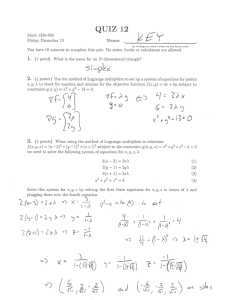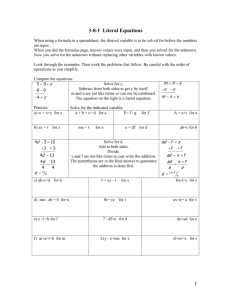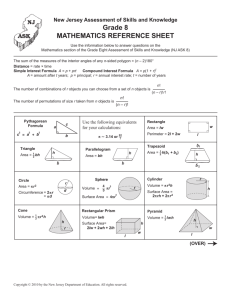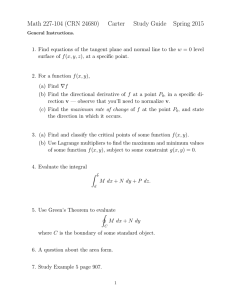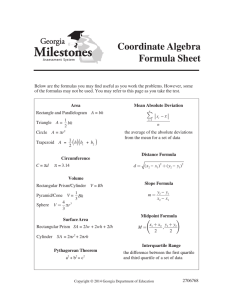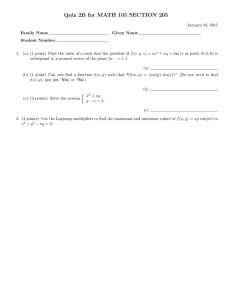Method of Lagrange Multipliers Example 1: f
advertisement
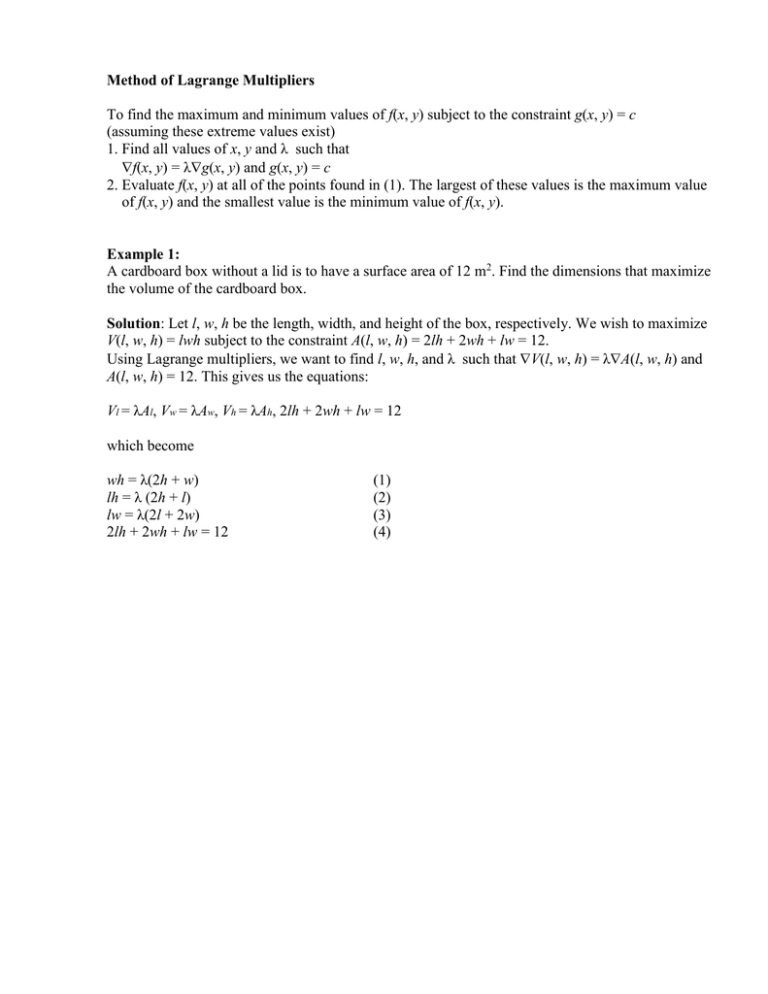
Method of Lagrange Multipliers To find the maximum and minimum values of f(x, y) subject to the constraint g(x, y) = c (assuming these extreme values exist) 1. Find all values of x, y and λ such that f(x, y) = λg(x, y) and g(x, y) = c 2. Evaluate f(x, y) at all of the points found in (1). The largest of these values is the maximum value of f(x, y) and the smallest value is the minimum value of f(x, y). Example 1: A cardboard box without a lid is to have a surface area of 12 m2. Find the dimensions that maximize the volume of the cardboard box. Solution: Let l, w, h be the length, width, and height of the box, respectively. We wish to maximize V(l, w, h) = lwh subject to the constraint A(l, w, h) = 2lh + 2wh + lw = 12. Using Lagrange multipliers, we want to find l, w, h, and λ such that V(l, w, h) = λA(l, w, h) and A(l, w, h) = 12. This gives us the equations: Vl = λAl, Vw = λAw, Vh = λAh, 2lh + 2wh + lw = 12 which become wh = λ(2h + w) lh = λ (2h + l) lw = λ(2l + 2w) 2lh + 2wh + lw = 12 (1) (2) (3) (4) There is no general rule for solving these systems of equations. Sometimes some ingenuity is required. Here, notice that if we multiply (1) by l, (2) by w, and (3) by h, then the left sides of these equations will be the same. That is, we have: lwh = λ(2lh + lw) lwh = λ(2wh + lw) lwh = λ(2lh + 2wh) (5) (6) (7) Notice that λ 0, since if it did, then wh = 0, lh = 0, and lw = 0 from (1), (2), and (3) which would contradict (4). Thus, we can set (5) and (6) equal and divide through by λ to get 2lh + lw = 2wh + lw. Subtracting lw from both sides and then dividing by 2, we see that lh = wh. But because h 0 (since this would imply that V = 0), we have that l = w. Setting (6) and (7) equal and dividing through by we get 2wh + lw = 2lh + 2wh. Subtracting 2wh from both sides, we have lw = 2lh. Since l 0 (since this would imply that V = 0), we have that w = 2h. Thus, we have that l = w = 2h. Substituting those values into the constraint equation, 2lh + 2wh + lw = 12, we have 2(2h)h + 2(2h)h + (2h)(2h) = 12h2 = 12. Since h must be positive, we see that h = 1. This implies that l = 2 and w = 2. Example 2: Find the smallest value of x2 + y2 subject to the constraint y + 3x = 3. Solution: Notice that f = 2xi + 2yj and g = 3i + j. Using Lagrange multipliers, we have f = λg, where λ is a scalar. This gives us the three equations 2x = 3 λ 2y = λ y + 3x = 3 (1) (2) (3) Solve for x and y in (1) and (2), respectively, we have x = (3/2) λ and y = λ /2. Plugging these into (3), we have (λ/2) + 3(3λ/2) = 3 5λ = 3. So λ = 3/5. Plugging in λ = 3/5 into our equations above, we see that x = 9/10 and y = 3/10. Example 3: Find the maximum and minimum values of the function f(x, y) = x2 + 2y2 that lie on the circle x2 + y2 = 1. Solution: Using Lagrange multipliers, we have f = λg, where λ is a scalar. This gives us the three equations 2x = 2xλ (1) 4y = 2yλ (2) 2 2 x +y =1 (3) From (1), we have that either x = 0 or λ = 1. If x = 0, then (3) tells us that y = 1. So, we have the points (0, 1). If λ = 1, then (2) gives us 4y = 2y, so y = 0. But if y = 0, (3) tells us that x 1. This gives us the points (1, 0). Evaluating f(x, y) at these four points, we have f(0, 1) = 2, f(0, –1) = 2, f(1, 0) = 1, and f(–1, 0) = 1. Thus, the maximum value of f(x, y) on the circle x2 + y2 = 1 is f(0, 1) = 2 and the minimum value is f(1, 0) = 1. Exercises 1. Use the method of Lagrange Multipliers to find the points on the cone z2 = x2 + y2 that are closest to the point (4, 2, 0). 2. What is the largest square that can be inscribed in the ellipse x2 + 2y2 = 1? 3. Use the method of Lagrange Multipliers to find the maximum and minimum values of x3 – y3 subject to the constraint x2 + y2 = 8. 4. A certain cylindrical can is to have a volume of 0.25 ft3. Find the height h and radius r of the can that will minimize surface area of the can. What is the relationship between the resulting r and h? 5. A rectangular box with a square bottom and an open top is to have a volume of 1000 ft3. What dimensions for the box yield the smallest surface area?
